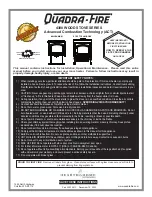
14
Regulations to be observed
●
Local and building law regulations
●
The stove must be installed by a professional and
connected to the chimney. The specific national
regulations for safe installation of the connector
must be complied with. The connecting piece
used must possess an opening for cleaning.
●
The stove must be regularly checked by a profes-
sional.
●
The stove has national technical approval from the
Deutsches Institut für Bautechnik (DIBt) (German
Institute for Civil Engineering) for room-air inde-
pendent operation.
Due to its general technical approval, the stove
can be used simultaneously with an approved
ventilation sys- tem without additional safety
device.
Equipped with a self-closing combustion chamber
door, the stove is approved to be connected to multi-
flue chimneys provided that it operates with a room-
air dependent combustion-air supply.
Room-air independent operation requires that the ex-
haust gases of the fireplace be discharged through a
single-flue chimney or the exhaust duct of a single-
flue air-exhaust chimney. Exhaust gases may also be
discharged into multi- flue exhaust gas systems if all
connected fireplaces are part of the same utilisation
unit/action range of the ventilation system. Individual
differences can be discussed with your district master
chimney sweep.
Chimney design
The chimney design is according to DIN EN 13384 -
1 and - 2 or to the specific national regulations.
The chimney must comply with the temperature
class T400.
Necessary data
Closed operation
with billet wood / wood briquettes:
●
Nominal thermal output ............................. 5,0 / 5,0 kW
●
Waste air mass flow rate ............................. 4,5 / 5,6 g/s
●
Waste air temperature at
connection duct .......................................... 330 / 320 °C
●
Minimum delivery pressure at
nominal thermal output. ................................ 12 / 12 Pa
Combustion air supply
The stove can be operated conventionally, dependent
on the ambient air as well as independent of the am-
bient air. It must be guaranteed that there is enough
combustion air available for the stove. For the proper
function of the stove, a necessary combustion air vol-
ume current of 18,7 m³/h must be considered.
Ambient air independ-
ent combustion air
connection
By an ambient air independent operating mode, the
com- bustion air must be added from outside
through a leak- proof line or through a supply duct
in the chimney. Thus, speak with your district chim-
ney sweep master.
Due to energy saving reasons, the combustion air
inlet should be able to be blocked if the stove is not
being operated. This can occur through a shut-off
valve in the combustion air line or through the air
slide valves on the stove. If a shut-off valve is used,
this must be clearly identified with CLOSED/OPEN.
Through the shutoff, it is avoided that heat is removed
from the set-up room through the constant circulation
of cold combustion air and cold combustion air lines
may lead to an increased formation of condensation.
Attention:
The combustion air line may not be closed
during operation!
In order to feed the combustion air to the stove exter-
nally via a pipe instead of from the room in which it is
installed, it is possible to screw a Ø 125 mm combus-
tion air pipe to the back of the stove or at the bottom.
If the combustion air pipe installed is longer than 3 m,
calculations will have to be carried out to verify an ad-
equate supply of combustion air. At extremely low
outdoor temperatures, condensation can occur on the
combustion air duct. For this reason it must be insu-
lated with a suitable insulating materi- al. Observe the
rules of the oven and air heating construction craft.
Use the Olsberg combustion air pipes with sealing lip.















































